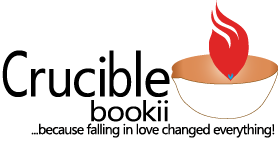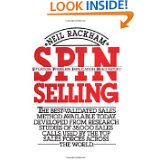SPIN Selling by Neil Rackham
By Neil Rackham
Review by Jennifer Dawson under Melanie’s direction
There’s a scene in the critically acclaimed but very nasty 1992 movie Glengarry Glen Ross that sticks in my head. Alec Baldwin, who plays a bad-ass consultant “from downtown” charged with increasing sales in a Chicago-based real estate office, introduces himself to his incredulous sales team with a profanity-peppered monologue. At one point he flips over a blackboard, revealing several chalked words, their first letter highlighted. Against an ominous backdrop of lightning flashes, Baldwin reviews the words. “A-B-C,” he rants. “A, Always, B, Be, C, Closing. Always be closing.”
ABC. Always Be Closing. According to Neil Rackham, a psychologist whose substantial research on the sales process has revolutionized sales training around the world, ABC has been a widely repeated sales mantra since the 1920s. But Rackham is a bit of an iconoclast. In his book Spin Selling—which was first published in 1988 and is still earning devoted followers around the world–Rackham asserts that ABC doesn’t work, at least for large sales with higher price tags and longer sales cycles.
SPIN stands for Situation, Problem, Implication and Need-payoff. Each word describes a kind of question that a salesperson should ask a prospect in order to strengthen the relationship and increase the perceived value of the product or service that is being sold. Rackham’s model is founded on questions: intelligent, considered in advance, and designed to help the customer see problems as needing to be solved and the salesperson as a problem solver.
Traditional sales training emphasizes “show and tell.” Salespeople guess at the needs of the customer and focus their pitch on relaying the features and benefits of what is being sold in order to close the deal. Rackham’s model is fundamentally different. Instead of “show and tell” we have “ask and listen.” Instead of the salesperson providing all the answers, we have the customer filling in the blanks. Instead of high pressure tactics we have solutions to problems. Instead of a one-time meeting and quick buck, we have an evolving relationship. Instead of salesperson as actor, we have salesperson as director.
SPIN questions have a primary purpose: they allow the salesperson to uncover a customer’s explicit needs in order to build a case for solving those needs with the salesperson’s product or service. The difference between an implied and explicit need is critical here. An implied need is an expression of discontent or dissatisfaction that doesn’t necessarily warrant the customer taking action. The current product or service may be difficult to use or result in an undesirable error rate, but the consequences aren’t considered dire enough to warrant the risk and expense of solving the problem by purchasing the kind of item offered in a major or large sale. An explicit need, however, is one where the customer sees the cost of the problem outweighs the cost of the salesperson’s solution. An implied need prompts headaches and sighs. An explicit need prompts action and is more likely to result in a purchase.
Rackham’s SPIN method teaches the salesperson to use questions to develop an implied need into an explicit need. He is clear that it’s a recipe, rather than a formula. Here are the basic ingredients:
- S- Situation questions establish the context. How many people work at the company? What product is the company using now? How old is the current system? Use situation questions early and sparingly. Research the company beforehand so the questions you ask are the important ones, since situation questions can be perceived by prospects as wasting their time.
- P- Problem questions reveal challenges with the current product or service. Is the customer satisfied with what the company is using now? Is it hard to learn? Are there any quality issues? If a salesperson can’t uncover any problems to solve, there is no basis for a relationship with the customer. Problem questions prompt customers to reveal their needs, but only their implied needs.
- I- Implication questions increase the perceived value of your product by helping the customer recognize the full cost of problems with the status quo. If the current system is hard to use, how does that impact employee morale? Turnover? Quality control? Efficiency? And what do each of those implications cost the company? Implication questions, for Rackham, are among the most important since they turn implied needs into explicit needs. The dissatisfaction that in the past prompted the customer to do little more than swallow a Tylenol now makes him or her see the value in taking much greater action. Decision-makers are fluent in the language of implication, since their jobs are usually based on determining the underlying effects and consequences of different actions. If you want to sell to a decision-maker, speak his or her language.
- N- Need-payoff questions allow the customer to see the value in your solution. Is it important to the company to solve this problem? Why is this solution useful? Can the customer see any other benefits to installing this system? These questions are solution rather than problem focused. They get the customer to supply the benefits, because only the customer truly understands the complexity of the problems experienced by the company. It’s easy to tell the difference between implication questions and need-payoff questions; as an 8-year old deduced and later shared with Rackham, the former leave you feeling sad and the latter leave you feeling happy. This is why need-payoff questions are particularly important when you need to establish a good relationship with the customer. Ask need-payoff questions towards the end of the sales process, or they are unlikely to be truly based on explicit needs and may be interpreted by the customer as glib and result in objections.
The benefits of SPIN are clearly outlined in Rackham’s book. In a large sale, where decisions are usually made over an extended period of time without the salesperson present, the SPIN process gives the customer the opportunity to rehearse for the inevitable challenge of selling the product internally. Because a SPIN sale is based on explicit needs, which cry out for action, it is easier for a salesperson to conclude a call with a concrete step forward. Finally, because the customer comes up with the benefits and identifies the value of the solution, objections are prevented rather than having to be “handled.”
According to Rackham, the objective of SPIN selling is not to close a sale, but to open a relationship. Had he been the consultant parachuted in to assist the struggling salesmen in Glengarry Glen Ross, the end result would have been completely different–a little less Oscar nominee, a little more training video, and a lot more sales. But, not surprisingly, SPIN is one four-letter word you don’t hear coming out of Alec Baldwin’s mouth.




